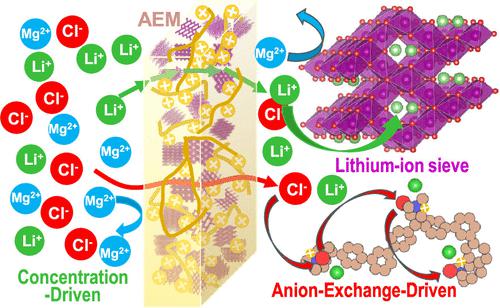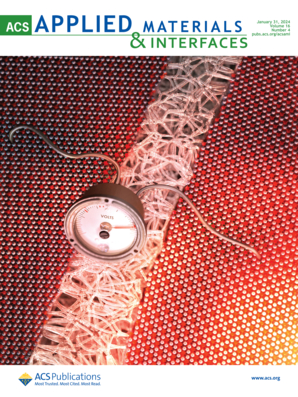用于阴离子交换和阳离子浓缩驱动的锂/镁分离的锂离子筛嵌入式混合膜
IF 8.3
2区 材料科学
Q1 MATERIALS SCIENCE, MULTIDISCIPLINARY
引用次数: 0
摘要
为满足日益增长的锂资源需求,迫切需要开发高效、环保的技术,从含有丰富 Mg2+ 的盐水中分离出 Li+。在这项研究中,我们将锂离子筛网氢氧化锰(HMO)作为填料,与阴离子交换膜(AEMs)、季铵官能化聚(2,6-二甲基-1,4-苯基氧化物)(QPPO)和聚(间三联苯哌啶)(m-PTP)结合,制备了混合膜。阳离子通过阴离子产生的静电吸引和跨膜浓度差进行运输。由于 AEM 中固定阳离子基团的静电排斥力和立体阻力的影响,电荷少、半径小的 Li+ 会优先通过膜。此外,HMO 的存在为 Li+ 提供了额外的快速传输通道,从而提高了 Li+/Mg2+ 的分离性能。结果表明,20%HMO@m-PTP 具有很高的 Li+ 通量(0.48 mol/m2-h)和 Li+/Mg2+ 选择性(βLi+/Mg2+ = 14.1)。分子动力学模拟显示,m-PTP 的自由体积比 QPPO 大,有利于阳离子的快速传输。光谱分析证实了 Li+ 在 HMO 中的插入和筛分。这项工作说明了基于锂离子筛的阴离子交换和阳离子浓度驱动混合膜在低能耗和高效 Li+ 提取过程中的巨大潜力。本文章由计算机程序翻译,如有差异,请以英文原文为准。

Lithium-Ion-Sieve-Embedded Hybrid Membranes for Anion-Exchange- and Cation-Concentration-Driven Li/Mg Separation
There is an urgent need to develop efficient and environmentally friendly technologies for separating Li+ from brines containing abundant Mg2+ to meet the growing demand for lithium resources. In this work, we prepared hybrid membranes by integrating hydrogen manganese oxide (HMO), a lithium-ion sieve, as a filler into anion-exchange membranes (AEMs), the quaternary ammonium-functionalized poly(2,6-dimethyl-1,4-phenylene oxide) (QPPO) and poly(m-terphenyl piperidinium) (m-PTP). Cations are transported by electrostatic attraction originating from anions and the concentration difference across membranes. Because of the effects of electrostatic repulsion of the fixed cationic groups and steric resistance in AEMs, Li+ with less charge and smaller radius will preferentially pass through the membrane. In addition, the presence of HMO provides an additional fast transport channel for Li+, resulting in an enhanced Li+/Mg2+ separation performance. The results show that 20%HMO@m-PTP exhibits high Li+ flux (0.48 mol/m2·h) and Li+/Mg2+ selectivity (βLi+/Mg2+ = 14.1). Molecular dynamics simulations show that m-PTP has more free volume than QPPO, which is beneficial for rapid cation transport. Spectral analysis confirms the insertion and sieving of Li+ in HMO. This work illustrates the great potential of anion-exchange- and cation-concentration-driven hybrid membranes based on lithium-ion sieves for low-energy and efficient Li+ extraction processes.
求助全文
通过发布文献求助,成功后即可免费获取论文全文。
去求助
来源期刊

ACS Applied Materials & Interfaces
工程技术-材料科学:综合
CiteScore
16.00
自引率
6.30%
发文量
4978
审稿时长
1.8 months
期刊介绍:
ACS Applied Materials & Interfaces is a leading interdisciplinary journal that brings together chemists, engineers, physicists, and biologists to explore the development and utilization of newly-discovered materials and interfacial processes for specific applications. Our journal has experienced remarkable growth since its establishment in 2009, both in terms of the number of articles published and the impact of the research showcased. We are proud to foster a truly global community, with the majority of published articles originating from outside the United States, reflecting the rapid growth of applied research worldwide.
 求助内容:
求助内容: 应助结果提醒方式:
应助结果提醒方式:


